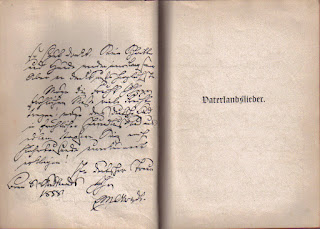The second violin I obtained via Freegle (number 9 in my logbook) came from outside Oxford and was very kindly delivered to my doorstep. It is a Chinese one from the 1960s and came with its original case and two hairless bows. It was lacking the bridge and the tailgut so I had to cut a new bridge, which is an enjoyable job to do. A lot of the filing and scraping is compatible with multitasking, so I watched the news and a movie while doing this. When the bridge was in a reasonable shape (I can always sand and scrape it a bit more at a later point but I was impatient), I set it up with a set of spare strings that came with the pair of SkyLark violins I bought recently. (There were only three strings in the case of this one and two of them were gut strings.) So now it looks quite lovely:
Building bridges is always a very satisfying job to do ...
I made the new tailgut from an old gut string that came with Heinrich the cello:
Note that the body is slightly thicker than the other violins I have. In fact the measures are identical to the 14" primavera viola I have, so I wondered whether this one was also meant to be a viola. I am told however, that it was only ever used as a violin (many years ago), so I also set it up as a violin. At first playing, it sounds surprisingly nice, even with a nondescript set of old strings. I am particularly impressed by the warm sound on the higher register - coming from the cello I have high expectations for the range where both instruments overlap, but don't expect to be wowed by the E string. Will share a video at some point. The attempt to record the same tune with all four violins for comparison taught me that it's a bad idea - I kept hitting the neighbouring strings as there are very subtle differences in the string height apparently.
On the label I first ignored the text in the round stamp, or maybe misread it as Shanghai. Only after the violin had settled in and sounded surprisingly good, I wondered again who made it and looked at the label again, and it says HsingHai - which I understand is a major manufacturer of all kinds of instruments, famous for pianos among other things.
So now I still need to rehair those bows:
This is the fifth violin I have managed to make playable (see details and links below). Two are now available for anybody who would want to play them - one for free and the other for a fee covering my costs. One has already been rehomed, one I'm playing myself and one stays for family history reasons.
Previously in the pirate luthier series:
violin 1) is the one my late aunt had since the 1930s, which got me started. After restoring it in November 2022, I played it almost every day for 14 months, until number 5) showed up.
violin 2) is a Stentor student 1 (a very widely used brand of cheap fiddles available everywhere and still being produced). It has a fault that is probably not worth repairing, see the blog entry on number 3) below. After stripping it of some accessories and spares, I am now inclined to keep it in a semi-functional state to try out experimental repairs, i.e. use it as a wooden guinea pig of sorts. Currently it is sporting a brand new tailgut which I made from an old cello C string.
violin 3) came from a folkie friend who moved away. I put the soundpost back in its place and it has now found a new home.
violin 5) (donated by a friendly freegler) is my new favourite and the one I currently play in folk sessions.
violin 7) is a skylark from 1991 which I bought on gumtree for £ 10 and fitted with a better bridge. Good enough for folk I would say.
violin 9) is the one discussed above
violin 10) is the broken one with traces of multiple repair attempts. I'm still gathering courage to try and fix that one.















































